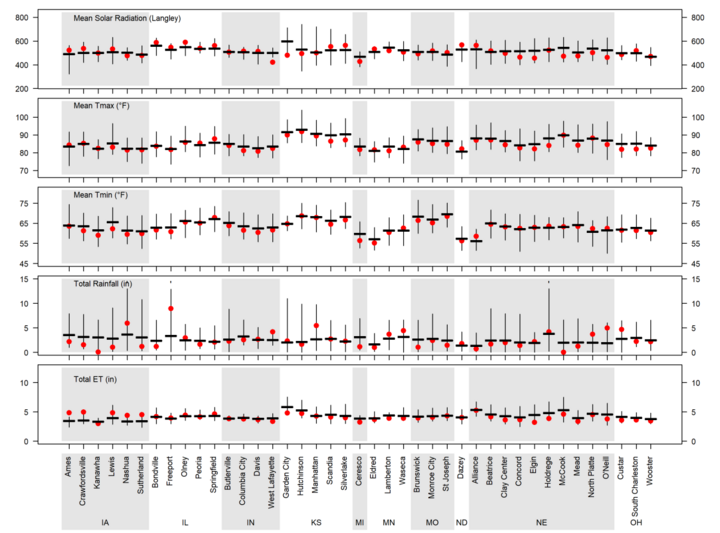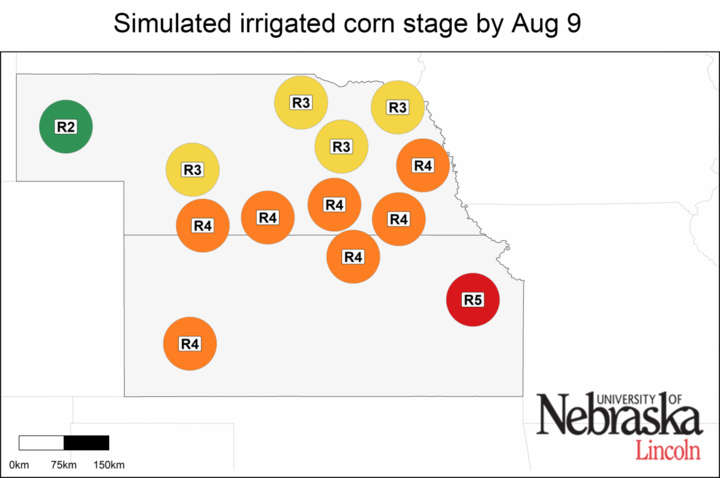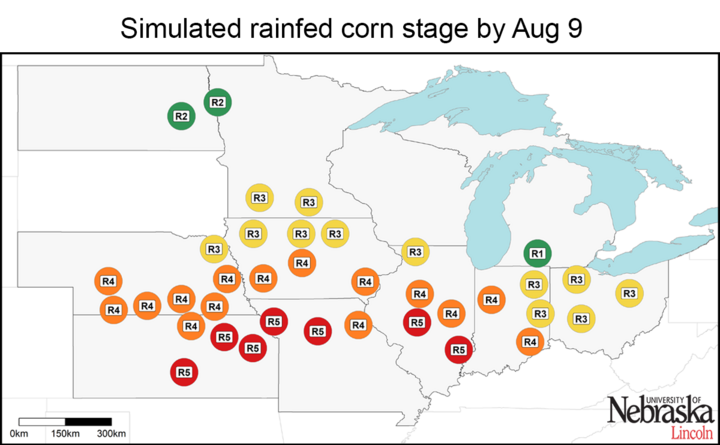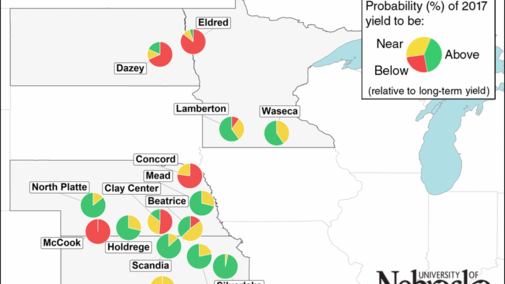Simulations of 2017 real-time crop stage are performed for 41 locations across the US Corn Belt using the UNL Hybrid-Maize crop model in collaboration with faculty and extension educators from 10 universities. Additionally, end-of-season forecasts of corn grain yield potential for all major irrigated corn growing regions and for rainfed corn in Nebraska, Kansas, North Dakota, and Minnesota will be provided. Download the Aug. 9 forecast data in Table 1. Details on the UNL Hybrid-Maize crop model and the underpinning methodology to simulate phenology and forecast end-of-season yields, as well as information on interpretation and uses of yield forecasts is described in a previous article.
The 2017 growing season continued with near average air temperatures during the end of July and early August. Radiation was below normal for most Nebraska locations. Rainfall was near normal for most locations, except in Iowa where there was below-normal rainfall. A summary of weather conditions since the July 22 yield forecast is shown in Figure 1.
Simulated Corn Stage Across 41 Locations
Grain filling is in full swing throughout Nebraska and the Corn Belt (Figure 2). Corn is still at blister stage at a few locations in the northern Corn Belt, including eastern North Dakota, northern Minnesota, western Nebraska, and southern Michigan.


Vn: vegetative stage (nth leaf); R1: silking; R2: blister; R3: milk; R4: dough; R5: dent; Matured (“black layer”).
Separate maps are shown for irrigated corn (above) and rainfed corn (right).

High Probability of Near-Average Yields for Irrigated Corn
The range of forecasted irrigated corn grain yield potential for each location, as well as the probabilities for yields above, near, or below average, are shown in Figures 3 and 4. Forecasted yield potential improved since the last forecast on July 22. One-third of the irrigated sites exhibit a high-probability (>75%) of near-average yield potential.
Two sites in Kansas exhibit a high probability of above-average yield potential. Weather conditions during the rest of the growing season will determine if the other irrigated sites will remain near-average yield potential or will achieve above-average yield. Overall, the chance of below-average yield appears to be low across all irrigated sites.
Figure 3. Vertical lines indicate the range of forecasted 2017 corn yield potential by July 18 based on average planting date in 2017 at each location. Horizontal lines indicate the 25th and 75th percentiles of the yield distribution (associated with respective adverse and favorable weather scenarios during the rest of the season). Long-term (2005-2016) average yield potential at each location is indicated with a blue square. Separate charts are shown for irrigated corn (left) and rainfed corn (right).



Variable 2017 Forecasted Corn Yield Across Rainfed Locations
Forecasted yield potential looks highly variable across rainfed sites (Figures 3 and 4). There is a relatively high probability of above-average yield along a northwest-southeast transect in Nebraska and Kansas, including North Platte, Holdrege, Scandia, Manhattan, and Silverlake. Our forecast does not capture the effect of severe temperature and/or water stress on pollen shedding and pollination so some of these forecasts (e.g., northeastern Kansas) need to be interpreted with caution. There is a high-probability of below-average yield in southwestern Nebraska (McCook), northeastern Nebraska (Concord), North Dakota, and northwestern Minnesota. The scenario is less clear for the other rainfed sites.
Conclusions
Forecasted yields followed the trends observed in the previous yield forecasts released on July 22. Growing conditions until August 9 indicate high probability of near-average yields at the irrigated sites. Forecasted yields look highly variable across rainfed locations. These forecasts do not take into consideration problems with stand emergence, hail/flooding damage, replanting situations, disease, or nitrate leaching. In fields negatively affected by these constraints, actual yields will be lower than estimates provided here.
It is important to keep in mind that yield forecasts are not field specific and, instead, represent an estimate of average on-farm yield for a given location and surrounding area in absence of the yield-reducing factors mentioned here. Likewise, crop stages and forecasted yields will deviate from the ones reported here in fields with planting dates or hybrid maturities that differ markedly from the planting dates or hybrid maturities used as the basis for the forecasts. We will follow up with further forecasts in late August.

